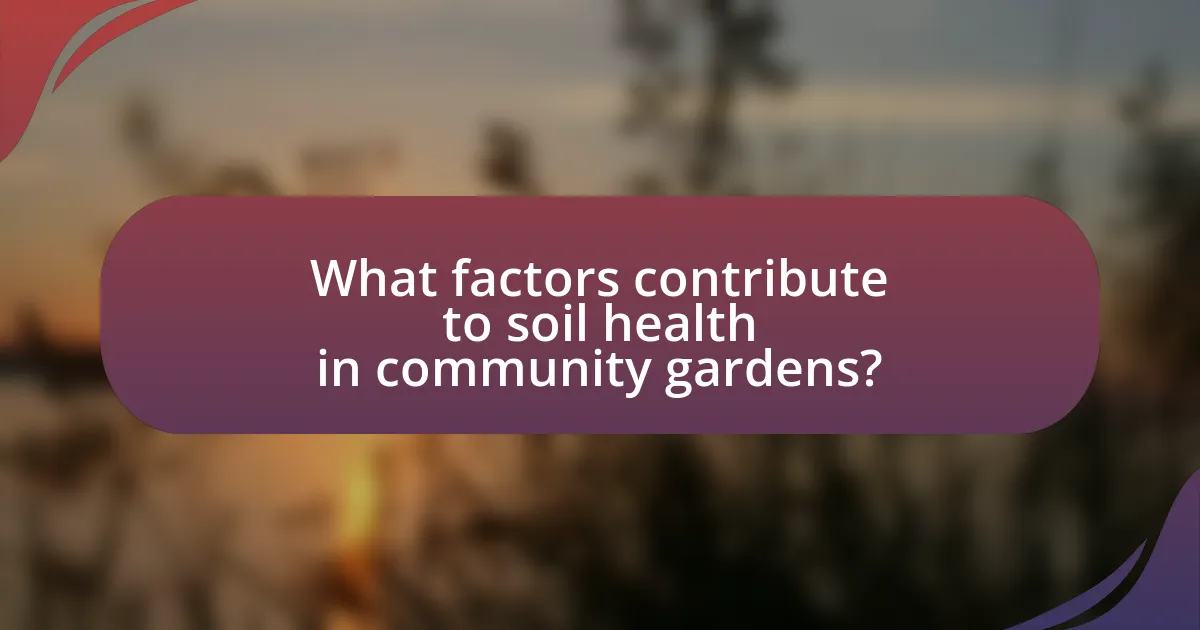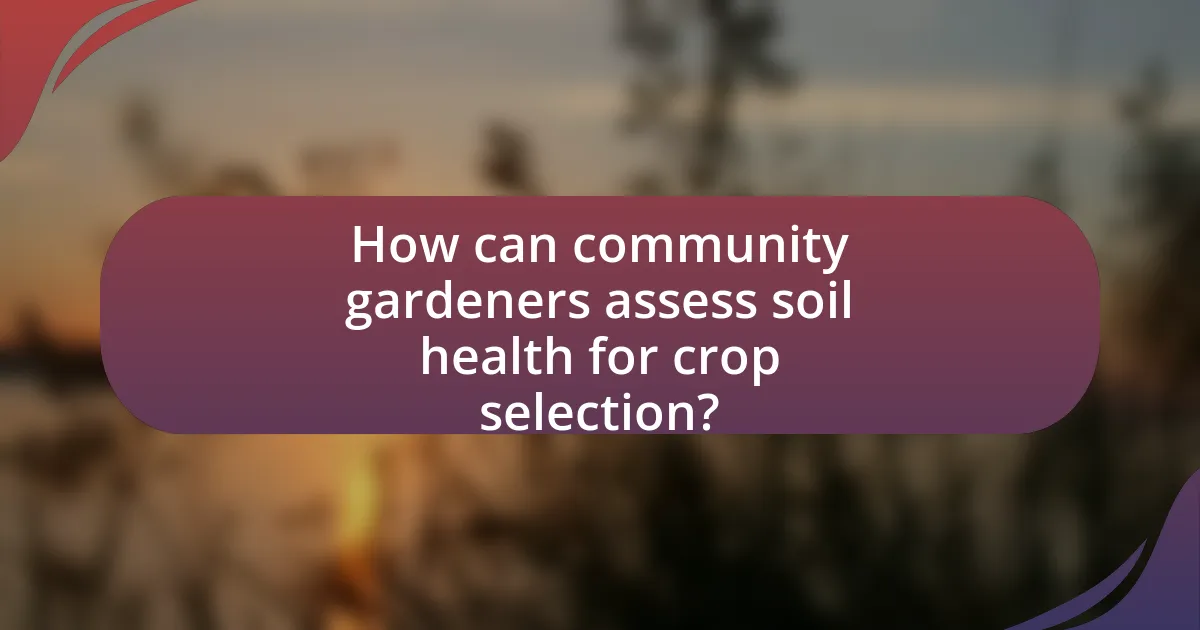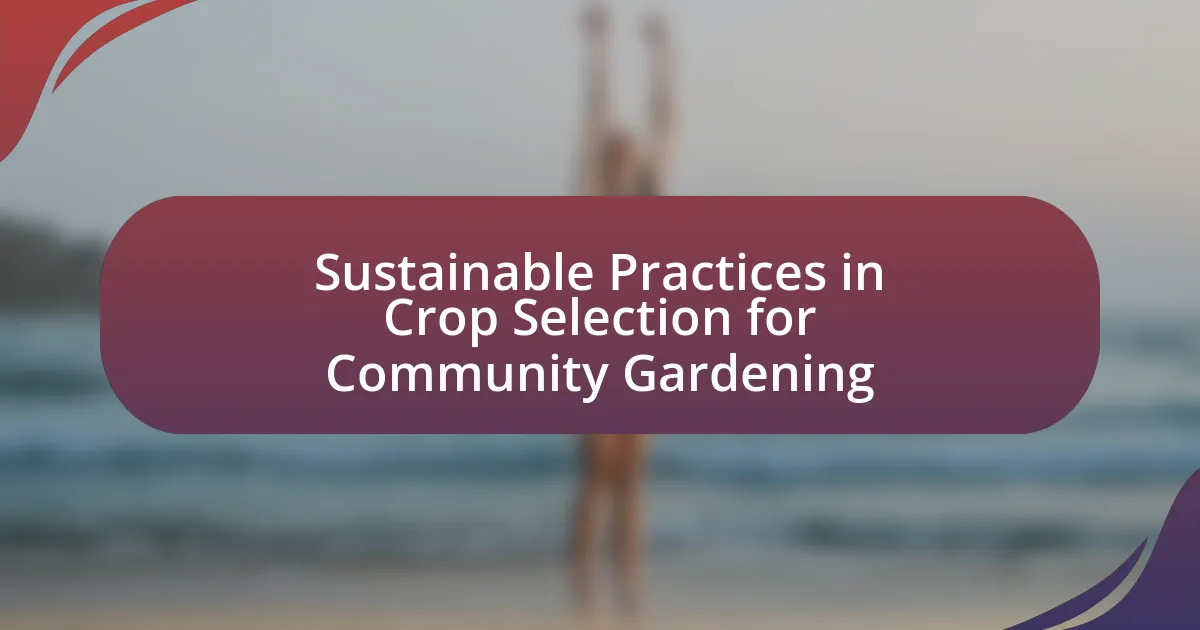The article focuses on the critical role of soil health in crop selection for community gardens. It emphasizes how healthy soil, characterized by balanced organic matter, nutrients, and microbial activity, directly influences plant growth, yield, and disease resistance. Key indicators of soil health, such as pH, nutrient availability, and soil texture, are discussed in relation to their impact on crop selection. The article also outlines best practices for improving soil health, including regular soil testing, organic amendments, and crop rotation, which collectively enhance sustainability and productivity in community gardening. Understanding these factors is essential for gardeners to optimize their crop choices and ensure successful gardening outcomes.

What is the role of soil health in crop selection for community gardens?
Soil health plays a critical role in crop selection for community gardens by influencing plant growth, nutrient availability, and disease resistance. Healthy soil contains a balanced mix of organic matter, microorganisms, and minerals, which support diverse plant species and enhance their productivity. Research indicates that soil with high organic matter improves water retention and nutrient cycling, making it more suitable for a variety of crops. For instance, studies have shown that gardens with well-maintained soil health can yield up to 20% more produce compared to those with poor soil conditions. Therefore, assessing soil health is essential for selecting crops that will thrive and contribute to the overall success of community gardens.
How does soil health influence crop growth in community gardens?
Soil health significantly influences crop growth in community gardens by affecting nutrient availability, water retention, and microbial activity. Healthy soil, characterized by a balanced pH, organic matter, and beneficial microorganisms, promotes optimal nutrient uptake for plants, leading to improved growth and yield. Research indicates that soils with high organic matter can retain moisture better, reducing the need for irrigation and enhancing plant resilience during dry periods. Additionally, a diverse microbial community in healthy soil aids in decomposing organic matter, which releases nutrients in forms that plants can readily absorb. Studies have shown that community gardens with well-maintained soil health can produce crops with higher nutritional value and greater resistance to pests and diseases, ultimately contributing to more sustainable gardening practices.
What are the key indicators of soil health relevant to crop selection?
Key indicators of soil health relevant to crop selection include soil texture, organic matter content, pH level, nutrient availability, and microbial activity. Soil texture affects water retention and aeration, influencing which crops can thrive; for instance, sandy soils drain quickly, favoring drought-resistant plants. Organic matter content enhances soil structure and nutrient supply, with higher levels supporting a wider variety of crops. The pH level determines nutrient solubility, with most crops preferring a pH between 6.0 and 7.5 for optimal nutrient uptake. Nutrient availability, particularly nitrogen, phosphorus, and potassium, directly impacts crop growth and yield. Lastly, microbial activity is crucial for nutrient cycling and soil fertility, with healthy microbial populations promoting robust plant growth. These indicators collectively guide effective crop selection in community gardens, ensuring sustainable and productive gardening practices.
How do soil nutrients affect the choice of crops in community gardens?
Soil nutrients significantly influence the choice of crops in community gardens by determining which plants can thrive in a given environment. Nutrient availability, such as nitrogen, phosphorus, and potassium, directly affects plant growth, yield, and health. For instance, crops like tomatoes and peppers require nutrient-rich soil to produce optimal yields, while root vegetables like carrots may tolerate lower nutrient levels. Research indicates that soil testing can guide gardeners in selecting appropriate crops based on nutrient profiles, ensuring better growth and sustainability. Therefore, understanding soil nutrient composition is essential for effective crop selection in community gardening.
Why is understanding soil health important for community gardeners?
Understanding soil health is crucial for community gardeners because it directly influences plant growth, crop yield, and overall garden sustainability. Healthy soil provides essential nutrients, supports beneficial microorganisms, and enhances water retention, which are all vital for robust plant development. Research indicates that soil rich in organic matter can increase crop yields by up to 20% compared to depleted soils. Additionally, understanding soil health allows gardeners to select appropriate crops that thrive in specific soil conditions, thereby optimizing their gardening efforts and promoting biodiversity.
What are the consequences of neglecting soil health in crop selection?
Neglecting soil health in crop selection leads to reduced crop yields and increased vulnerability to pests and diseases. When soil health is compromised, essential nutrients become depleted, resulting in poor plant growth and lower productivity. Research indicates that healthy soils contribute to higher crop resilience; for instance, a study published in the journal “Agriculture, Ecosystems & Environment” found that well-managed soils can increase yields by up to 30% compared to degraded soils. Additionally, poor soil health can lead to increased soil erosion and water runoff, further exacerbating agricultural challenges.
How can soil health impact the sustainability of community gardens?
Soil health significantly impacts the sustainability of community gardens by influencing plant growth, nutrient availability, and ecosystem balance. Healthy soil promotes robust root systems, which enhances water retention and reduces the need for irrigation, thereby conserving resources. Additionally, nutrient-rich soil supports diverse plant species, leading to increased biodiversity, which can improve pest control and pollination. Research indicates that gardens with healthy soil can yield up to 30% more produce compared to those with degraded soil, demonstrating the direct correlation between soil quality and garden productivity. Furthermore, maintaining soil health through practices like composting and crop rotation fosters long-term sustainability by preventing soil erosion and degradation, ensuring that community gardens can thrive for generations.

What factors contribute to soil health in community gardens?
Soil health in community gardens is primarily influenced by organic matter content, soil structure, microbial activity, and nutrient availability. Organic matter, such as compost and mulch, enhances soil fertility and moisture retention, while a well-structured soil promotes aeration and root penetration. Microbial activity is crucial for nutrient cycling and disease suppression, as diverse microbial communities break down organic materials and release essential nutrients. Additionally, balanced nutrient availability, including macronutrients like nitrogen, phosphorus, and potassium, as well as micronutrients, supports healthy plant growth. Research indicates that gardens with higher organic matter and microbial diversity yield better crops, demonstrating the direct link between these factors and soil health.
How do organic matter and microbial activity affect soil health?
Organic matter and microbial activity significantly enhance soil health by improving nutrient availability, soil structure, and water retention. Organic matter, such as decomposed plant and animal materials, serves as a reservoir of nutrients, releasing essential elements like nitrogen, phosphorus, and potassium as it breaks down. This process supports microbial communities, which play a crucial role in nutrient cycling and organic matter decomposition.
Microbial activity contributes to soil health by promoting the formation of soil aggregates, which improves aeration and water infiltration. Research indicates that soils rich in organic matter can retain up to 50% more water than those with low organic content, thereby enhancing drought resilience. Furthermore, healthy microbial populations can suppress soil-borne diseases, reducing the need for chemical inputs in community gardens.
In summary, the interplay between organic matter and microbial activity is vital for maintaining soil health, which directly influences crop productivity and sustainability in community gardens.
What role does compost play in enhancing soil health?
Compost significantly enhances soil health by improving its structure, fertility, and microbial activity. The organic matter in compost increases soil aeration and water retention, which promotes root growth and nutrient uptake. Additionally, compost enriches the soil with essential nutrients such as nitrogen, phosphorus, and potassium, which are vital for plant growth. Research indicates that compost application can increase soil organic matter content by 2-5%, leading to improved soil quality and crop yields. Furthermore, compost supports a diverse microbial community, which is crucial for nutrient cycling and disease suppression in plants.
How does soil pH influence crop selection in community gardens?
Soil pH significantly influences crop selection in community gardens by determining nutrient availability and plant health. Different crops thrive at specific pH levels; for instance, most vegetables prefer a pH range of 6.0 to 7.5, where essential nutrients like nitrogen, phosphorus, and potassium are readily available. Conversely, crops such as blueberries require more acidic conditions, typically between 4.5 and 5.5, to absorb nutrients effectively. Research indicates that soil pH directly affects microbial activity, which in turn influences nutrient cycling and plant growth. Therefore, understanding the pH of garden soil is crucial for selecting appropriate crops that will flourish in that environment.
What practices can improve soil health for better crop selection?
Practices that can improve soil health for better crop selection include crop rotation, cover cropping, and organic amendments. Crop rotation enhances soil structure and nutrient availability by alternating different plant families, which reduces pest and disease cycles. Cover cropping, such as planting legumes, adds organic matter and improves soil fertility while preventing erosion. Organic amendments, like compost or manure, enrich the soil with essential nutrients and beneficial microorganisms. Research indicates that these practices can lead to a 20-30% increase in crop yields, demonstrating their effectiveness in enhancing soil health and supporting diverse crop selection.
How can crop rotation benefit soil health in community gardens?
Crop rotation can significantly benefit soil health in community gardens by enhancing nutrient availability and reducing soil erosion. By alternating different crops, gardeners can prevent nutrient depletion, as various plants have unique nutrient requirements and contribute differently to soil fertility. For instance, legumes can fix nitrogen in the soil, enriching it for subsequent crops. Additionally, crop rotation disrupts pest and disease cycles, minimizing the need for chemical interventions and promoting a healthier ecosystem. Research indicates that implementing crop rotation can increase soil organic matter and improve soil structure, leading to better water retention and aeration, which are crucial for plant growth.
What are the best soil amendment practices for community gardeners?
The best soil amendment practices for community gardeners include incorporating organic matter, using cover crops, and applying mulch. Organic matter, such as compost or well-rotted manure, improves soil structure, enhances nutrient availability, and promotes beneficial microbial activity. Research indicates that adding 25-30% organic matter can significantly increase soil fertility and water retention (Source: “Soil Organic Matter: The Key to Soil Health,” USDA Natural Resources Conservation Service). Cover crops, like clover or rye, prevent erosion, suppress weeds, and fix nitrogen in the soil, contributing to overall soil health. Additionally, applying mulch helps retain moisture, regulate soil temperature, and reduce weed competition, further supporting healthy plant growth. These practices collectively enhance soil quality, which is crucial for successful crop selection and yield in community gardens.

How can community gardeners assess soil health for crop selection?
Community gardeners can assess soil health for crop selection by conducting soil tests that measure pH, nutrient levels, and organic matter content. Soil testing provides quantitative data that indicates the soil’s fertility and suitability for various crops. For instance, a pH level between 6.0 and 7.5 is generally optimal for most vegetables, while nutrient tests can reveal deficiencies in nitrogen, phosphorus, or potassium, which are critical for plant growth. Additionally, assessing soil texture and structure helps determine water retention and drainage capabilities, influencing crop choices. Research from the USDA emphasizes that understanding these soil characteristics enables gardeners to select crops that thrive in their specific soil conditions, ultimately leading to better yields and healthier plants.
What methods are available for testing soil health?
Methods available for testing soil health include chemical analysis, biological assessment, and physical evaluation. Chemical analysis measures nutrient levels, pH, and contaminants, providing insights into soil fertility and toxicity. Biological assessment evaluates microbial activity and diversity, indicating soil ecosystem health. Physical evaluation examines soil structure, texture, and moisture retention, which affect plant growth. These methods collectively offer a comprehensive understanding of soil health, essential for informed crop selection in community gardens.
How can gardeners interpret soil test results for crop selection?
Gardeners can interpret soil test results for crop selection by analyzing key indicators such as pH, nutrient levels, and organic matter content. These indicators inform gardeners about the suitability of their soil for specific crops; for example, a pH level between 6.0 and 7.0 is generally ideal for most vegetables, while certain crops like blueberries thrive in more acidic soils with a pH below 5.5. Nutrient levels, including nitrogen, phosphorus, and potassium, are critical as they directly affect plant growth; a soil test revealing low nitrogen may suggest the need for nitrogen-fixing crops or amendments. Additionally, organic matter content indicates soil fertility and structure, with higher levels supporting better water retention and microbial activity, which benefits a wider range of crops. Therefore, by correlating these soil test results with the specific requirements of potential crops, gardeners can make informed decisions that enhance crop yield and health.
What tools can assist in monitoring soil health over time?
Tools that can assist in monitoring soil health over time include soil moisture sensors, pH meters, and soil nutrient testing kits. Soil moisture sensors provide real-time data on moisture levels, which is crucial for understanding water availability for crops. pH meters measure the acidity or alkalinity of the soil, affecting nutrient availability and microbial activity. Soil nutrient testing kits allow for the assessment of essential nutrients like nitrogen, phosphorus, and potassium, enabling informed decisions on fertilization and crop selection. These tools collectively contribute to a comprehensive understanding of soil health, which is vital for optimizing crop yields in community gardens.
What are the best practices for selecting crops based on soil health?
The best practices for selecting crops based on soil health include conducting soil tests, understanding soil texture and composition, and choosing crops that enhance soil fertility. Conducting soil tests provides essential information about nutrient levels, pH, and organic matter content, which are critical for determining suitable crops. Understanding soil texture and composition helps in selecting crops that thrive in specific conditions, such as sandy or clay soils. Additionally, choosing cover crops or legumes can improve soil health by fixing nitrogen and increasing organic matter, thereby enhancing the overall fertility and structure of the soil. These practices ensure that crop selection aligns with the specific health and needs of the soil, promoting sustainable gardening practices.
How can community gardeners match crops to specific soil conditions?
Community gardeners can match crops to specific soil conditions by conducting soil tests to determine pH, nutrient levels, and texture. Soil tests provide essential data that informs gardeners about the specific needs of their soil, allowing them to select crops that thrive in those conditions. For instance, crops like tomatoes prefer slightly acidic soil (pH 6.0-6.8), while root vegetables such as carrots thrive in loamy, well-drained soil. Research indicates that understanding soil composition can significantly enhance crop yield and health, as evidenced by studies showing that tailored crop selection based on soil analysis can increase productivity by up to 30%.
What resources are available for community gardeners to learn about soil health and crop selection?
Community gardeners can access various resources to learn about soil health and crop selection, including local agricultural extension services, online platforms like the USDA’s Natural Resources Conservation Service, and educational workshops offered by gardening organizations. These resources provide research-based information on soil testing, nutrient management, and suitable crop varieties for specific soil types. For instance, the USDA’s NRCS offers comprehensive guides and tools that help gardeners understand soil composition and improve soil health, which is crucial for selecting appropriate crops. Additionally, community colleges and universities often host classes and seminars focused on sustainable gardening practices, further enhancing gardeners’ knowledge in these areas.
What practical tips can enhance soil health and crop selection in community gardens?
To enhance soil health and crop selection in community gardens, implement practices such as regular soil testing, organic matter addition, and crop rotation. Regular soil testing allows gardeners to understand nutrient levels and pH, ensuring that amendments are tailored to specific needs. Adding organic matter, like compost or well-rotted manure, improves soil structure, water retention, and microbial activity, which are crucial for healthy plant growth. Crop rotation prevents nutrient depletion and reduces pest and disease buildup by alternating plant families, promoting biodiversity. These practices are supported by research indicating that healthy soil leads to improved crop yields and resilience against environmental stressors.





